Strategic Management Report: Strategic Analysis of Air Asia's Success
VerifiedAdded on 2020/05/28
|31
|6925
|219
Report
AI Summary
This report provides a comprehensive analysis of strategic management principles, focusing on globalization, innovation, and sustainability within the context of the airline industry, specifically examining Air Asia. The report is divided into two parts. Part A explores the strategic management process in the context of globalization, discussing challenges such as communication, currency fluctuations, cultural innovation, legal risks, and product lifecycle sustainability, emphasizing the role of leadership. It then analyzes Air Asia's competitive advantages, applying Porter's Five Forces to assess the airline's market position and competitive strategies. Part B delves into competitive tourism in Malaysia and Singapore, comparing their tourism industries and impact. The second part of B further analyzes Air Asia's mission and vision statements, cascading effects, and competitive advantages, concluding with a research-based approach to maintaining market sustainability. The report utilizes various academic references to support its analysis and provides insights into the strategic decisions that have contributed to Air Asia's success.
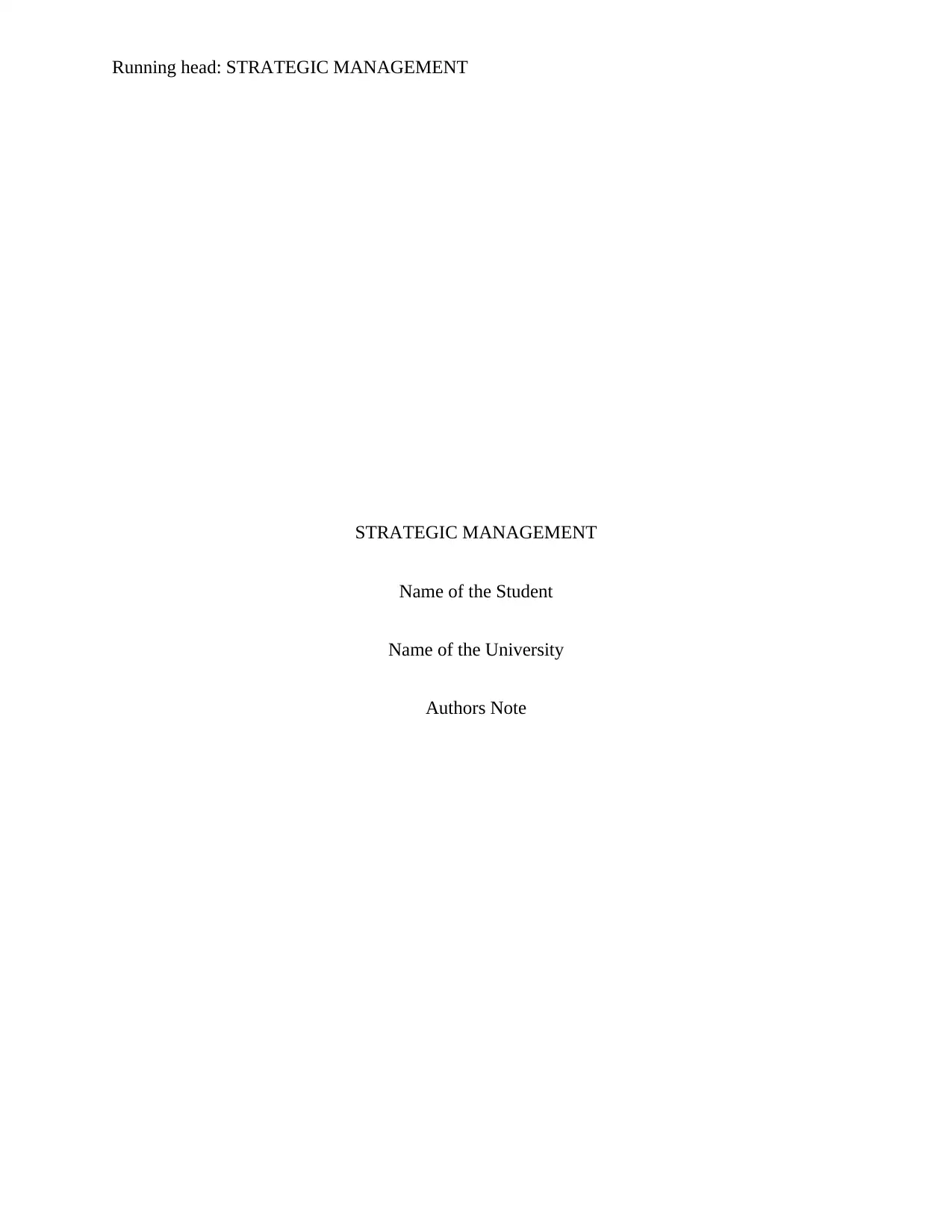
Running head: STRATEGIC MANAGEMENT
STRATEGIC MANAGEMENT
Name of the Student
Name of the University
Authors Note
STRATEGIC MANAGEMENT
Name of the Student
Name of the University
Authors Note
Paraphrase This Document
Need a fresh take? Get an instant paraphrase of this document with our AI Paraphraser
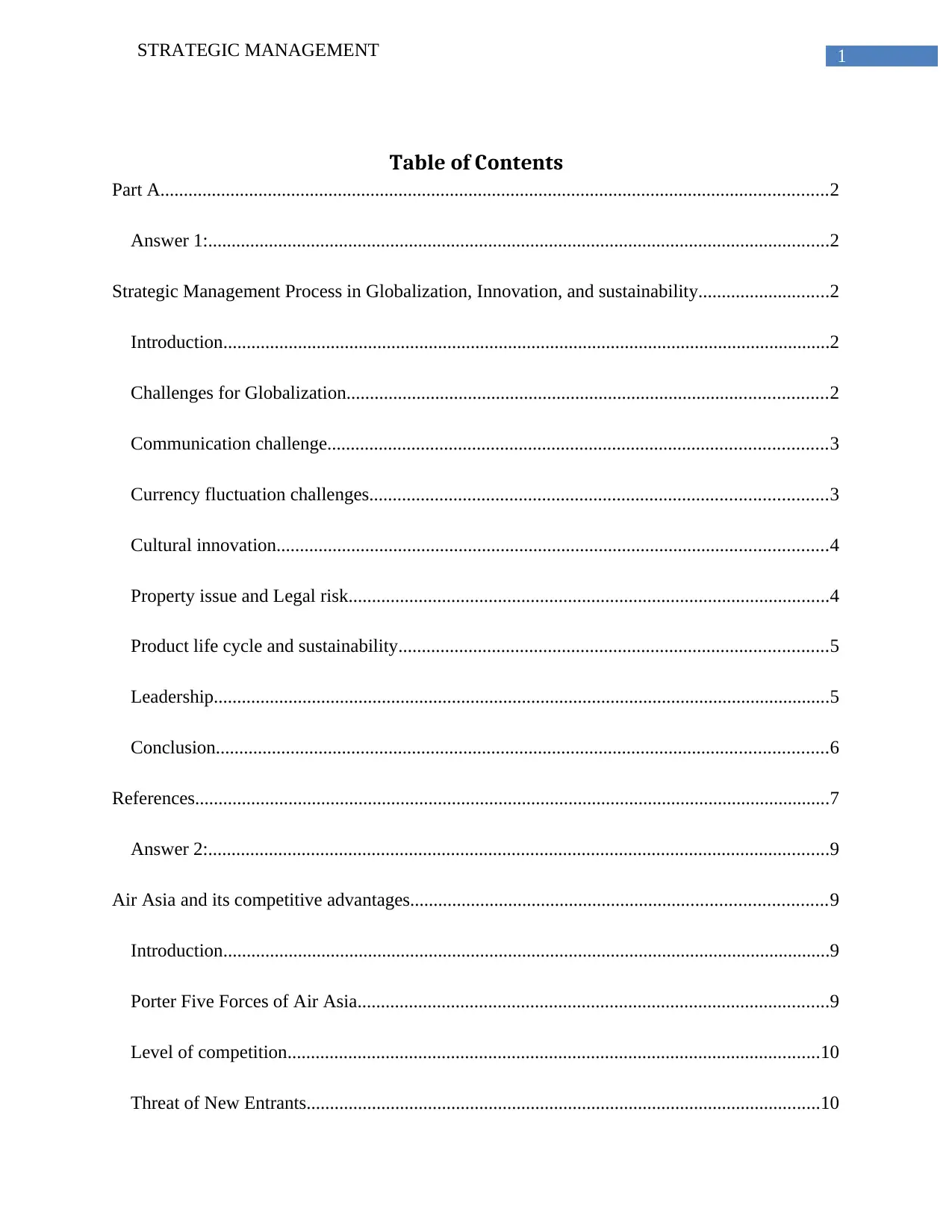
1STRATEGIC MANAGEMENT
Table of Contents
Part A...............................................................................................................................................2
Answer 1:.....................................................................................................................................2
Strategic Management Process in Globalization, Innovation, and sustainability............................2
Introduction..................................................................................................................................2
Challenges for Globalization.......................................................................................................2
Communication challenge...........................................................................................................3
Currency fluctuation challenges..................................................................................................3
Cultural innovation......................................................................................................................4
Property issue and Legal risk.......................................................................................................4
Product life cycle and sustainability............................................................................................5
Leadership....................................................................................................................................5
Conclusion...................................................................................................................................6
References........................................................................................................................................7
Answer 2:.....................................................................................................................................9
Air Asia and its competitive advantages.........................................................................................9
Introduction..................................................................................................................................9
Porter Five Forces of Air Asia.....................................................................................................9
Level of competition..................................................................................................................10
Threat of New Entrants..............................................................................................................10
Table of Contents
Part A...............................................................................................................................................2
Answer 1:.....................................................................................................................................2
Strategic Management Process in Globalization, Innovation, and sustainability............................2
Introduction..................................................................................................................................2
Challenges for Globalization.......................................................................................................2
Communication challenge...........................................................................................................3
Currency fluctuation challenges..................................................................................................3
Cultural innovation......................................................................................................................4
Property issue and Legal risk.......................................................................................................4
Product life cycle and sustainability............................................................................................5
Leadership....................................................................................................................................5
Conclusion...................................................................................................................................6
References........................................................................................................................................7
Answer 2:.....................................................................................................................................9
Air Asia and its competitive advantages.........................................................................................9
Introduction..................................................................................................................................9
Porter Five Forces of Air Asia.....................................................................................................9
Level of competition..................................................................................................................10
Threat of New Entrants..............................................................................................................10
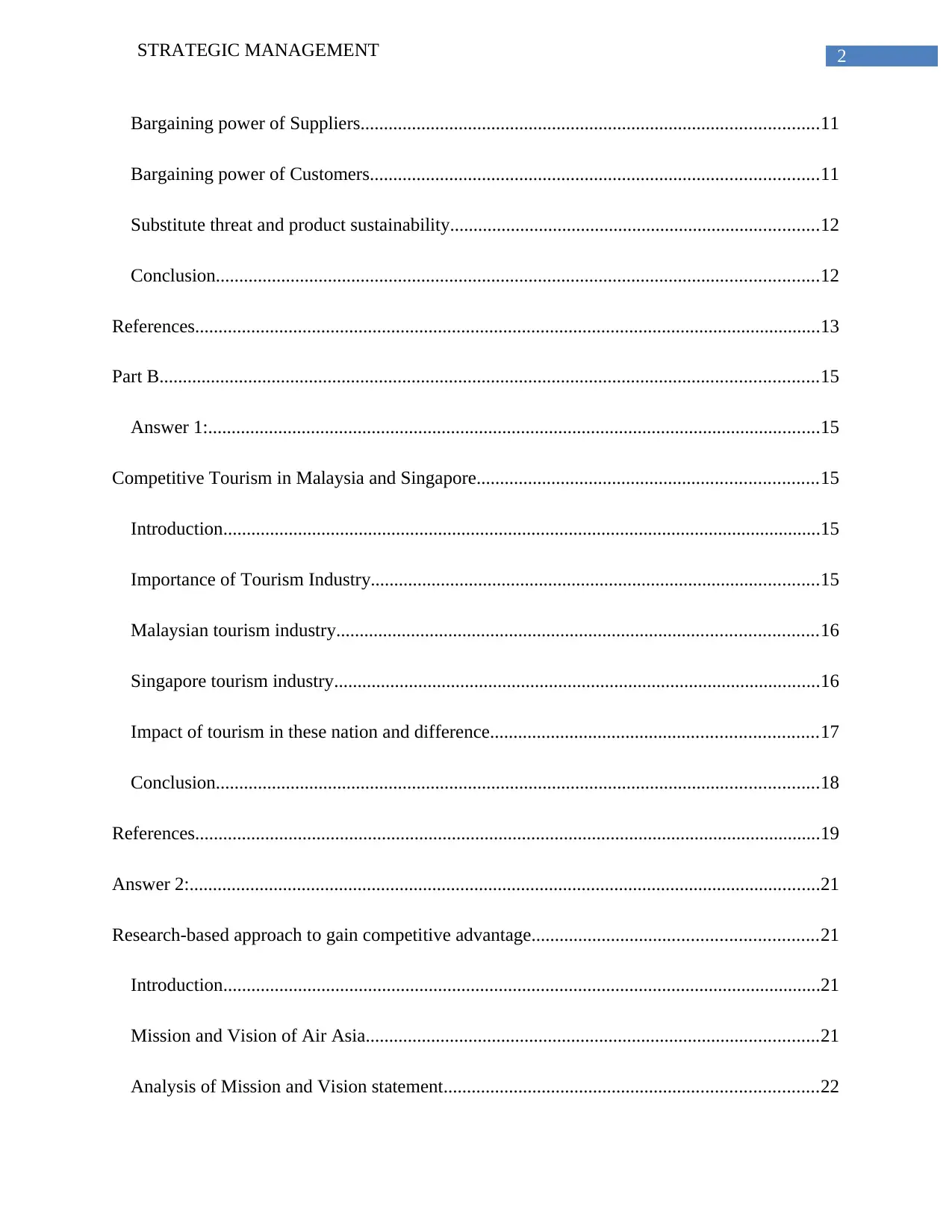
2STRATEGIC MANAGEMENT
Bargaining power of Suppliers..................................................................................................11
Bargaining power of Customers................................................................................................11
Substitute threat and product sustainability...............................................................................12
Conclusion.................................................................................................................................12
References......................................................................................................................................13
Part B.............................................................................................................................................15
Answer 1:...................................................................................................................................15
Competitive Tourism in Malaysia and Singapore.........................................................................15
Introduction................................................................................................................................15
Importance of Tourism Industry................................................................................................15
Malaysian tourism industry.......................................................................................................16
Singapore tourism industry........................................................................................................16
Impact of tourism in these nation and difference......................................................................17
Conclusion.................................................................................................................................18
References......................................................................................................................................19
Answer 2:.......................................................................................................................................21
Research-based approach to gain competitive advantage.............................................................21
Introduction................................................................................................................................21
Mission and Vision of Air Asia.................................................................................................21
Analysis of Mission and Vision statement................................................................................22
Bargaining power of Suppliers..................................................................................................11
Bargaining power of Customers................................................................................................11
Substitute threat and product sustainability...............................................................................12
Conclusion.................................................................................................................................12
References......................................................................................................................................13
Part B.............................................................................................................................................15
Answer 1:...................................................................................................................................15
Competitive Tourism in Malaysia and Singapore.........................................................................15
Introduction................................................................................................................................15
Importance of Tourism Industry................................................................................................15
Malaysian tourism industry.......................................................................................................16
Singapore tourism industry........................................................................................................16
Impact of tourism in these nation and difference......................................................................17
Conclusion.................................................................................................................................18
References......................................................................................................................................19
Answer 2:.......................................................................................................................................21
Research-based approach to gain competitive advantage.............................................................21
Introduction................................................................................................................................21
Mission and Vision of Air Asia.................................................................................................21
Analysis of Mission and Vision statement................................................................................22
⊘ This is a preview!⊘
Do you want full access?
Subscribe today to unlock all pages.

Trusted by 1+ million students worldwide
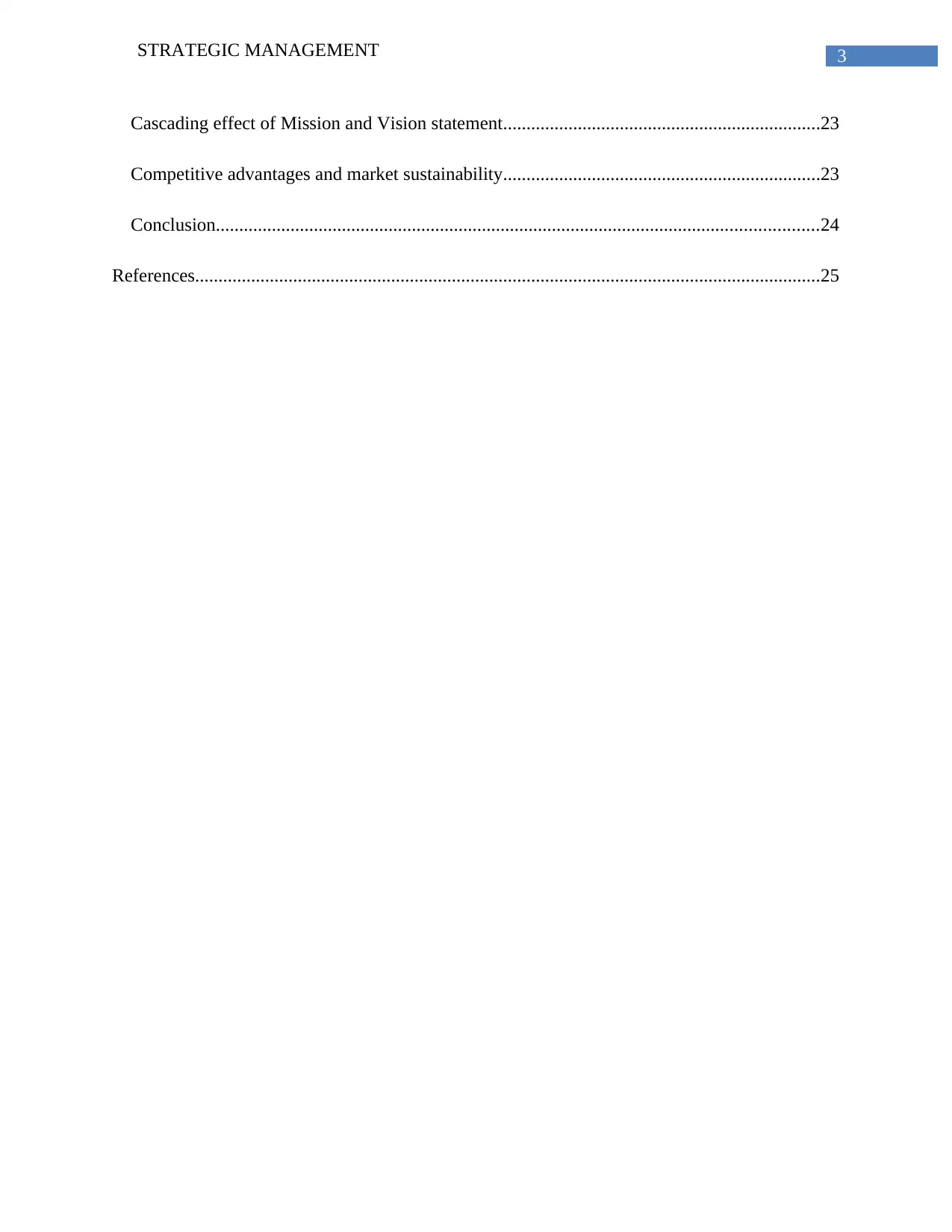
3STRATEGIC MANAGEMENT
Cascading effect of Mission and Vision statement....................................................................23
Competitive advantages and market sustainability....................................................................23
Conclusion.................................................................................................................................24
References......................................................................................................................................25
Cascading effect of Mission and Vision statement....................................................................23
Competitive advantages and market sustainability....................................................................23
Conclusion.................................................................................................................................24
References......................................................................................................................................25
Paraphrase This Document
Need a fresh take? Get an instant paraphrase of this document with our AI Paraphraser
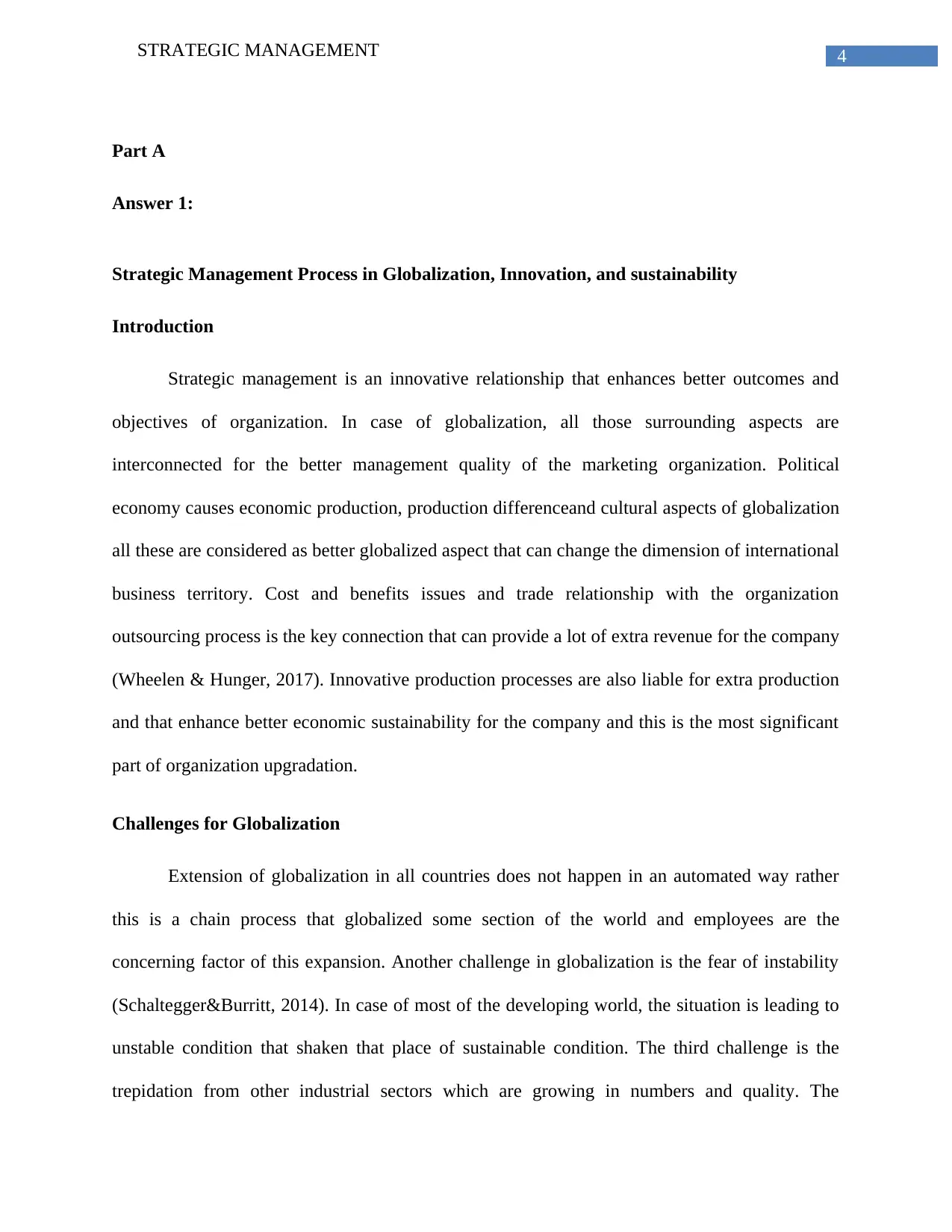
4STRATEGIC MANAGEMENT
Part A
Answer 1:
Strategic Management Process in Globalization, Innovation, and sustainability
Introduction
Strategic management is an innovative relationship that enhances better outcomes and
objectives of organization. In case of globalization, all those surrounding aspects are
interconnected for the better management quality of the marketing organization. Political
economy causes economic production, production differenceand cultural aspects of globalization
all these are considered as better globalized aspect that can change the dimension of international
business territory. Cost and benefits issues and trade relationship with the organization
outsourcing process is the key connection that can provide a lot of extra revenue for the company
(Wheelen & Hunger, 2017). Innovative production processes are also liable for extra production
and that enhance better economic sustainability for the company and this is the most significant
part of organization upgradation.
Challenges for Globalization
Extension of globalization in all countries does not happen in an automated way rather
this is a chain process that globalized some section of the world and employees are the
concerning factor of this expansion. Another challenge in globalization is the fear of instability
(Schaltegger&Burritt, 2014). In case of most of the developing world, the situation is leading to
unstable condition that shaken that place of sustainable condition. The third challenge is the
trepidation from other industrial sectors which are growing in numbers and quality. The
Part A
Answer 1:
Strategic Management Process in Globalization, Innovation, and sustainability
Introduction
Strategic management is an innovative relationship that enhances better outcomes and
objectives of organization. In case of globalization, all those surrounding aspects are
interconnected for the better management quality of the marketing organization. Political
economy causes economic production, production differenceand cultural aspects of globalization
all these are considered as better globalized aspect that can change the dimension of international
business territory. Cost and benefits issues and trade relationship with the organization
outsourcing process is the key connection that can provide a lot of extra revenue for the company
(Wheelen & Hunger, 2017). Innovative production processes are also liable for extra production
and that enhance better economic sustainability for the company and this is the most significant
part of organization upgradation.
Challenges for Globalization
Extension of globalization in all countries does not happen in an automated way rather
this is a chain process that globalized some section of the world and employees are the
concerning factor of this expansion. Another challenge in globalization is the fear of instability
(Schaltegger&Burritt, 2014). In case of most of the developing world, the situation is leading to
unstable condition that shaken that place of sustainable condition. The third challenge is the
trepidation from other industrial sectors which are growing in numbers and quality. The
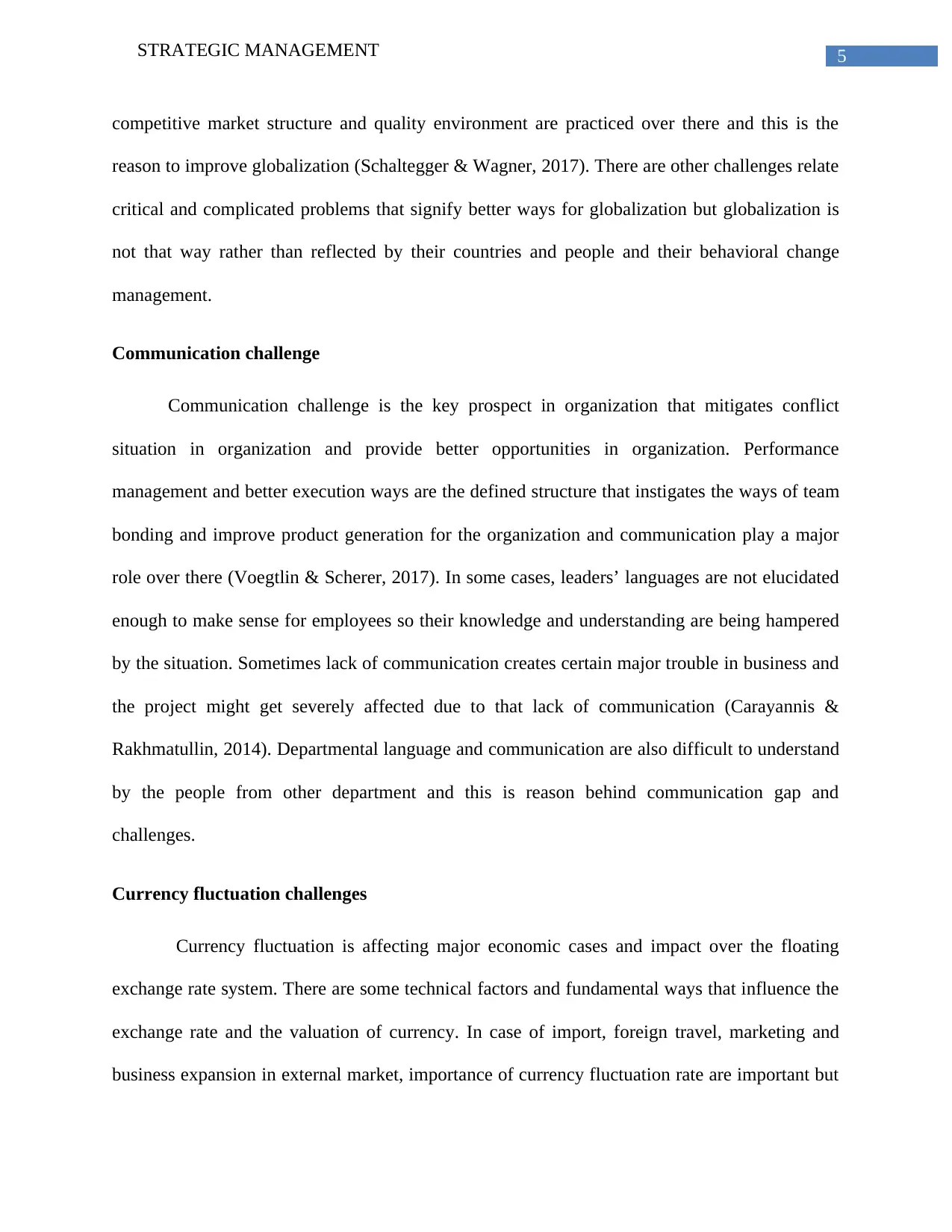
5STRATEGIC MANAGEMENT
competitive market structure and quality environment are practiced over there and this is the
reason to improve globalization (Schaltegger & Wagner, 2017). There are other challenges relate
critical and complicated problems that signify better ways for globalization but globalization is
not that way rather than reflected by their countries and people and their behavioral change
management.
Communication challenge
Communication challenge is the key prospect in organization that mitigates conflict
situation in organization and provide better opportunities in organization. Performance
management and better execution ways are the defined structure that instigates the ways of team
bonding and improve product generation for the organization and communication play a major
role over there (Voegtlin & Scherer, 2017). In some cases, leaders’ languages are not elucidated
enough to make sense for employees so their knowledge and understanding are being hampered
by the situation. Sometimes lack of communication creates certain major trouble in business and
the project might get severely affected due to that lack of communication (Carayannis &
Rakhmatullin, 2014). Departmental language and communication are also difficult to understand
by the people from other department and this is reason behind communication gap and
challenges.
Currency fluctuation challenges
Currency fluctuation is affecting major economic cases and impact over the floating
exchange rate system. There are some technical factors and fundamental ways that influence the
exchange rate and the valuation of currency. In case of import, foreign travel, marketing and
business expansion in external market, importance of currency fluctuation rate are important but
competitive market structure and quality environment are practiced over there and this is the
reason to improve globalization (Schaltegger & Wagner, 2017). There are other challenges relate
critical and complicated problems that signify better ways for globalization but globalization is
not that way rather than reflected by their countries and people and their behavioral change
management.
Communication challenge
Communication challenge is the key prospect in organization that mitigates conflict
situation in organization and provide better opportunities in organization. Performance
management and better execution ways are the defined structure that instigates the ways of team
bonding and improve product generation for the organization and communication play a major
role over there (Voegtlin & Scherer, 2017). In some cases, leaders’ languages are not elucidated
enough to make sense for employees so their knowledge and understanding are being hampered
by the situation. Sometimes lack of communication creates certain major trouble in business and
the project might get severely affected due to that lack of communication (Carayannis &
Rakhmatullin, 2014). Departmental language and communication are also difficult to understand
by the people from other department and this is reason behind communication gap and
challenges.
Currency fluctuation challenges
Currency fluctuation is affecting major economic cases and impact over the floating
exchange rate system. There are some technical factors and fundamental ways that influence the
exchange rate and the valuation of currency. In case of import, foreign travel, marketing and
business expansion in external market, importance of currency fluctuation rate are important but
⊘ This is a preview!⊘
Do you want full access?
Subscribe today to unlock all pages.

Trusted by 1+ million students worldwide
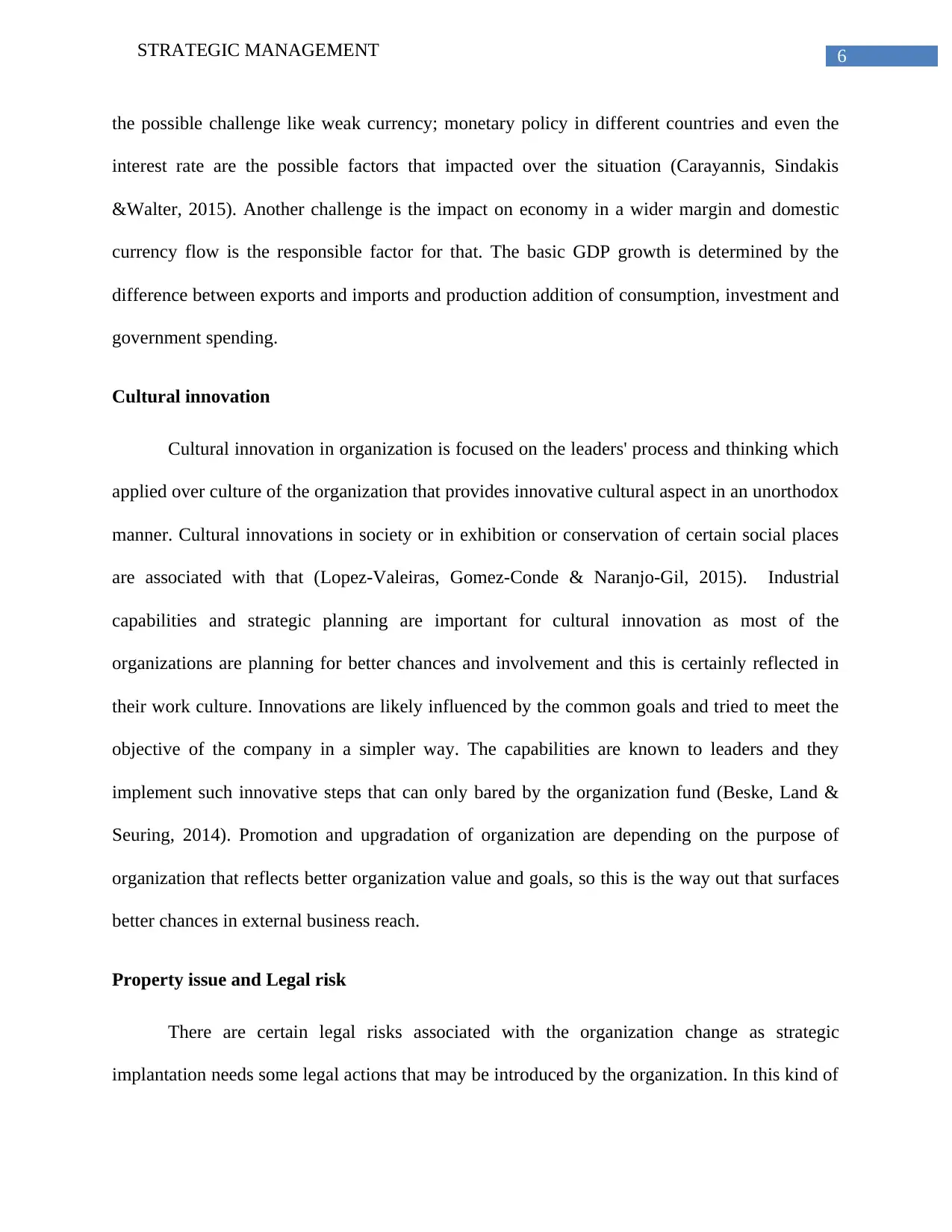
6STRATEGIC MANAGEMENT
the possible challenge like weak currency; monetary policy in different countries and even the
interest rate are the possible factors that impacted over the situation (Carayannis, Sindakis
&Walter, 2015). Another challenge is the impact on economy in a wider margin and domestic
currency flow is the responsible factor for that. The basic GDP growth is determined by the
difference between exports and imports and production addition of consumption, investment and
government spending.
Cultural innovation
Cultural innovation in organization is focused on the leaders' process and thinking which
applied over culture of the organization that provides innovative cultural aspect in an unorthodox
manner. Cultural innovations in society or in exhibition or conservation of certain social places
are associated with that (Lopez-Valeiras, Gomez-Conde & Naranjo-Gil, 2015). Industrial
capabilities and strategic planning are important for cultural innovation as most of the
organizations are planning for better chances and involvement and this is certainly reflected in
their work culture. Innovations are likely influenced by the common goals and tried to meet the
objective of the company in a simpler way. The capabilities are known to leaders and they
implement such innovative steps that can only bared by the organization fund (Beske, Land &
Seuring, 2014). Promotion and upgradation of organization are depending on the purpose of
organization that reflects better organization value and goals, so this is the way out that surfaces
better chances in external business reach.
Property issue and Legal risk
There are certain legal risks associated with the organization change as strategic
implantation needs some legal actions that may be introduced by the organization. In this kind of
the possible challenge like weak currency; monetary policy in different countries and even the
interest rate are the possible factors that impacted over the situation (Carayannis, Sindakis
&Walter, 2015). Another challenge is the impact on economy in a wider margin and domestic
currency flow is the responsible factor for that. The basic GDP growth is determined by the
difference between exports and imports and production addition of consumption, investment and
government spending.
Cultural innovation
Cultural innovation in organization is focused on the leaders' process and thinking which
applied over culture of the organization that provides innovative cultural aspect in an unorthodox
manner. Cultural innovations in society or in exhibition or conservation of certain social places
are associated with that (Lopez-Valeiras, Gomez-Conde & Naranjo-Gil, 2015). Industrial
capabilities and strategic planning are important for cultural innovation as most of the
organizations are planning for better chances and involvement and this is certainly reflected in
their work culture. Innovations are likely influenced by the common goals and tried to meet the
objective of the company in a simpler way. The capabilities are known to leaders and they
implement such innovative steps that can only bared by the organization fund (Beske, Land &
Seuring, 2014). Promotion and upgradation of organization are depending on the purpose of
organization that reflects better organization value and goals, so this is the way out that surfaces
better chances in external business reach.
Property issue and Legal risk
There are certain legal risks associated with the organization change as strategic
implantation needs some legal actions that may be introduced by the organization. In this kind of
Paraphrase This Document
Need a fresh take? Get an instant paraphrase of this document with our AI Paraphraser
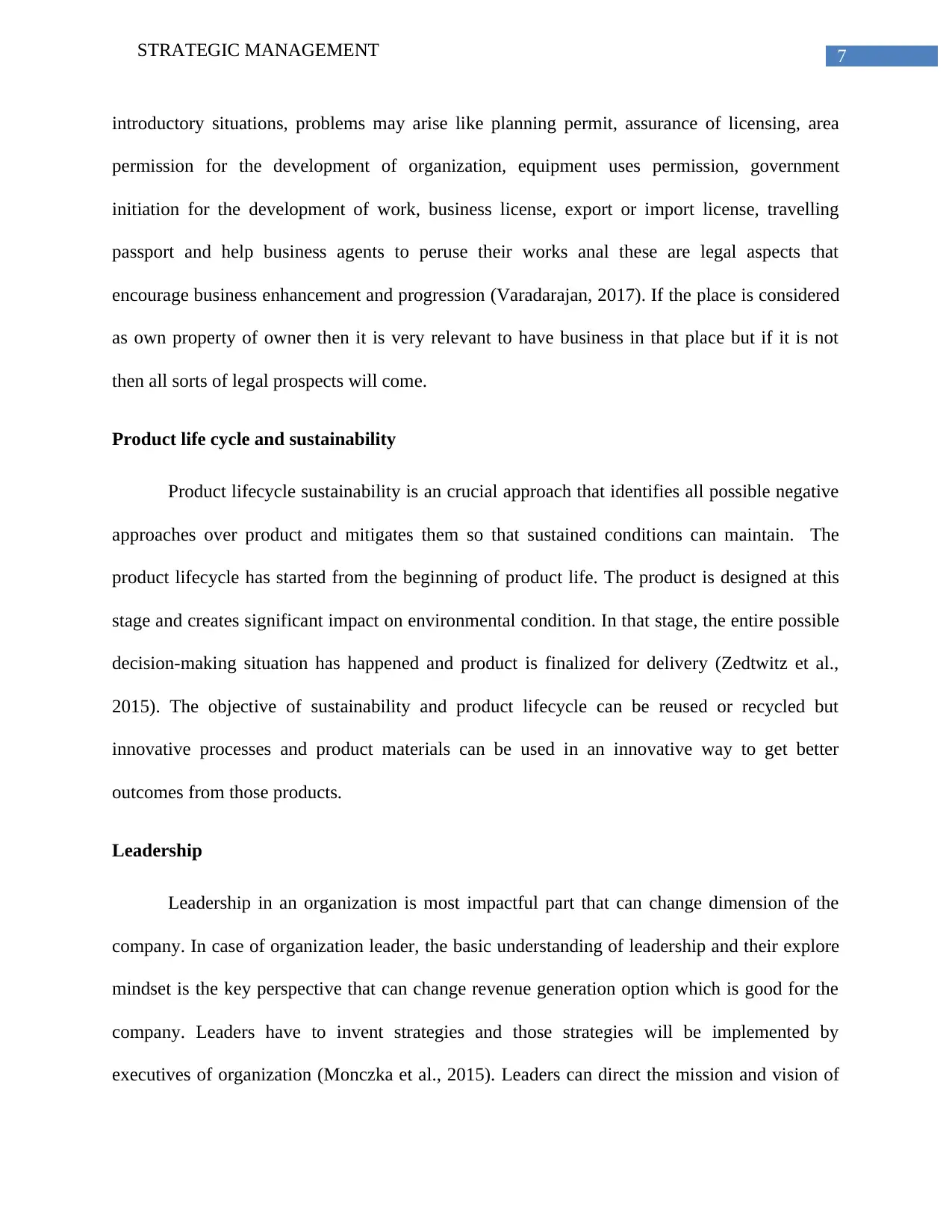
7STRATEGIC MANAGEMENT
introductory situations, problems may arise like planning permit, assurance of licensing, area
permission for the development of organization, equipment uses permission, government
initiation for the development of work, business license, export or import license, travelling
passport and help business agents to peruse their works anal these are legal aspects that
encourage business enhancement and progression (Varadarajan, 2017). If the place is considered
as own property of owner then it is very relevant to have business in that place but if it is not
then all sorts of legal prospects will come.
Product life cycle and sustainability
Product lifecycle sustainability is an crucial approach that identifies all possible negative
approaches over product and mitigates them so that sustained conditions can maintain. The
product lifecycle has started from the beginning of product life. The product is designed at this
stage and creates significant impact on environmental condition. In that stage, the entire possible
decision-making situation has happened and product is finalized for delivery (Zedtwitz et al.,
2015). The objective of sustainability and product lifecycle can be reused or recycled but
innovative processes and product materials can be used in an innovative way to get better
outcomes from those products.
Leadership
Leadership in an organization is most impactful part that can change dimension of the
company. In case of organization leader, the basic understanding of leadership and their explore
mindset is the key perspective that can change revenue generation option which is good for the
company. Leaders have to invent strategies and those strategies will be implemented by
executives of organization (Monczka et al., 2015). Leaders can direct the mission and vision of
introductory situations, problems may arise like planning permit, assurance of licensing, area
permission for the development of organization, equipment uses permission, government
initiation for the development of work, business license, export or import license, travelling
passport and help business agents to peruse their works anal these are legal aspects that
encourage business enhancement and progression (Varadarajan, 2017). If the place is considered
as own property of owner then it is very relevant to have business in that place but if it is not
then all sorts of legal prospects will come.
Product life cycle and sustainability
Product lifecycle sustainability is an crucial approach that identifies all possible negative
approaches over product and mitigates them so that sustained conditions can maintain. The
product lifecycle has started from the beginning of product life. The product is designed at this
stage and creates significant impact on environmental condition. In that stage, the entire possible
decision-making situation has happened and product is finalized for delivery (Zedtwitz et al.,
2015). The objective of sustainability and product lifecycle can be reused or recycled but
innovative processes and product materials can be used in an innovative way to get better
outcomes from those products.
Leadership
Leadership in an organization is most impactful part that can change dimension of the
company. In case of organization leader, the basic understanding of leadership and their explore
mindset is the key perspective that can change revenue generation option which is good for the
company. Leaders have to invent strategies and those strategies will be implemented by
executives of organization (Monczka et al., 2015). Leaders can direct the mission and vision of
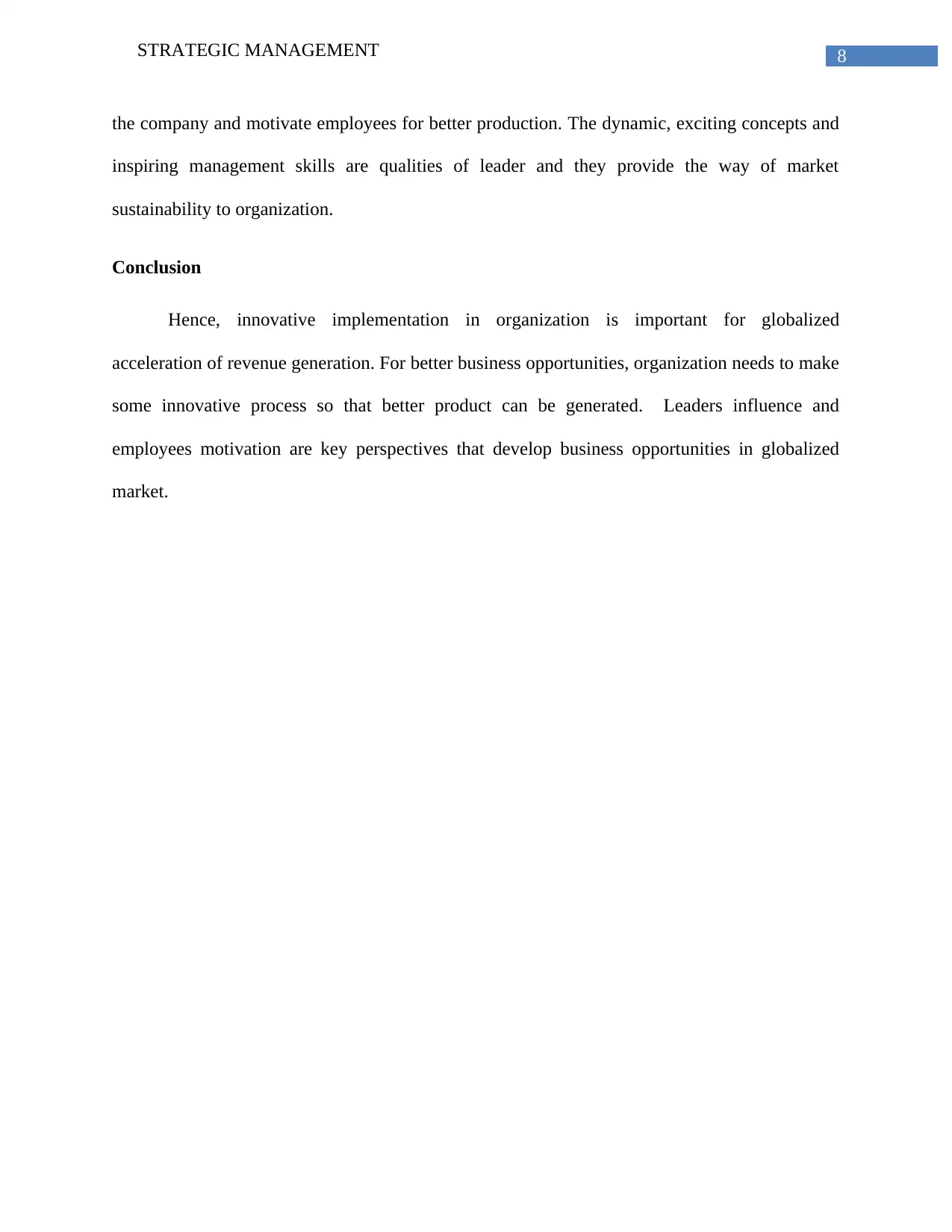
8STRATEGIC MANAGEMENT
the company and motivate employees for better production. The dynamic, exciting concepts and
inspiring management skills are qualities of leader and they provide the way of market
sustainability to organization.
Conclusion
Hence, innovative implementation in organization is important for globalized
acceleration of revenue generation. For better business opportunities, organization needs to make
some innovative process so that better product can be generated. Leaders influence and
employees motivation are key perspectives that develop business opportunities in globalized
market.
the company and motivate employees for better production. The dynamic, exciting concepts and
inspiring management skills are qualities of leader and they provide the way of market
sustainability to organization.
Conclusion
Hence, innovative implementation in organization is important for globalized
acceleration of revenue generation. For better business opportunities, organization needs to make
some innovative process so that better product can be generated. Leaders influence and
employees motivation are key perspectives that develop business opportunities in globalized
market.
⊘ This is a preview!⊘
Do you want full access?
Subscribe today to unlock all pages.

Trusted by 1+ million students worldwide
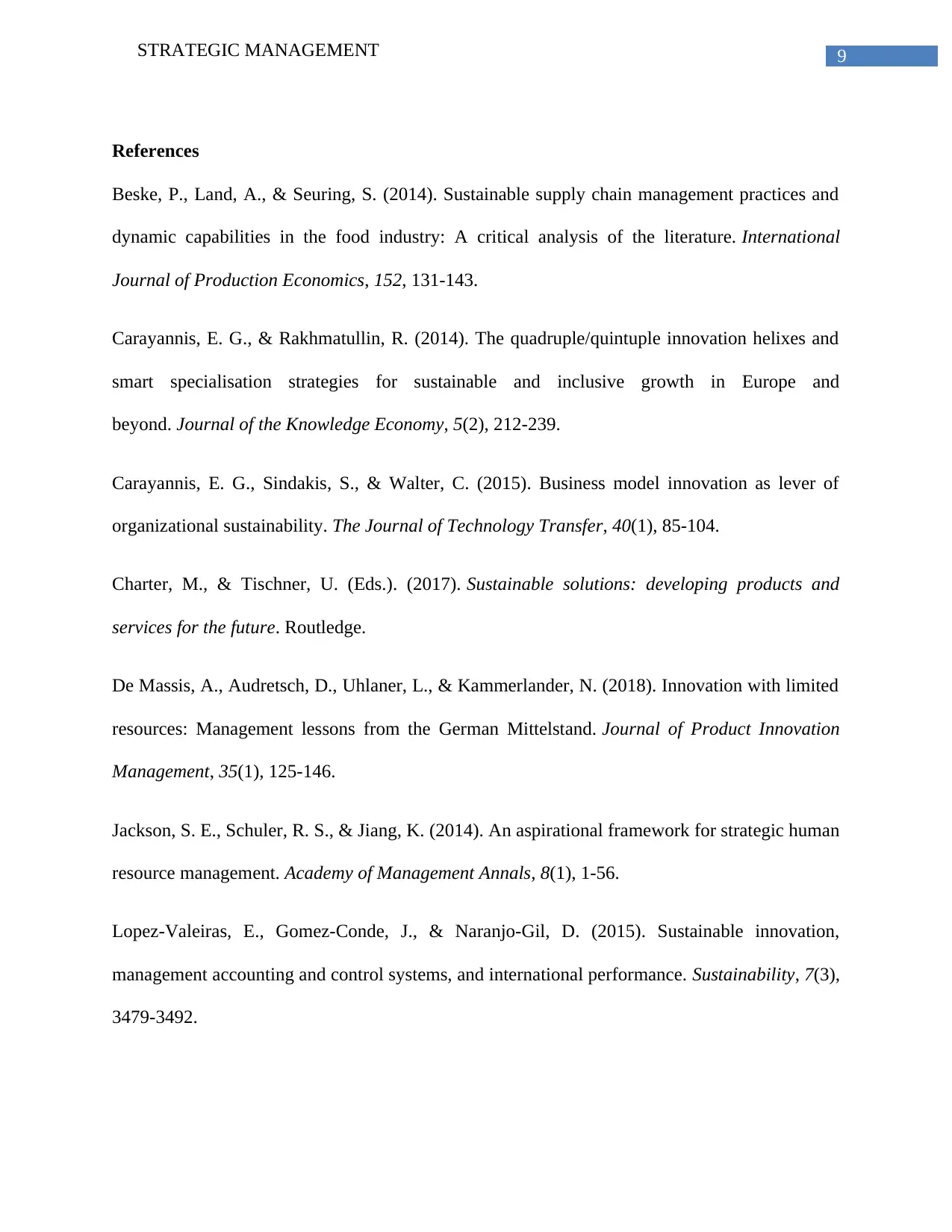
9STRATEGIC MANAGEMENT
References
Beske, P., Land, A., & Seuring, S. (2014). Sustainable supply chain management practices and
dynamic capabilities in the food industry: A critical analysis of the literature. International
Journal of Production Economics, 152, 131-143.
Carayannis, E. G., & Rakhmatullin, R. (2014). The quadruple/quintuple innovation helixes and
smart specialisation strategies for sustainable and inclusive growth in Europe and
beyond. Journal of the Knowledge Economy, 5(2), 212-239.
Carayannis, E. G., Sindakis, S., & Walter, C. (2015). Business model innovation as lever of
organizational sustainability. The Journal of Technology Transfer, 40(1), 85-104.
Charter, M., & Tischner, U. (Eds.). (2017). Sustainable solutions: developing products and
services for the future. Routledge.
De Massis, A., Audretsch, D., Uhlaner, L., & Kammerlander, N. (2018). Innovation with limited
resources: Management lessons from the German Mittelstand. Journal of Product Innovation
Management, 35(1), 125-146.
Jackson, S. E., Schuler, R. S., & Jiang, K. (2014). An aspirational framework for strategic human
resource management. Academy of Management Annals, 8(1), 1-56.
Lopez-Valeiras, E., Gomez-Conde, J., & Naranjo-Gil, D. (2015). Sustainable innovation,
management accounting and control systems, and international performance. Sustainability, 7(3),
3479-3492.
References
Beske, P., Land, A., & Seuring, S. (2014). Sustainable supply chain management practices and
dynamic capabilities in the food industry: A critical analysis of the literature. International
Journal of Production Economics, 152, 131-143.
Carayannis, E. G., & Rakhmatullin, R. (2014). The quadruple/quintuple innovation helixes and
smart specialisation strategies for sustainable and inclusive growth in Europe and
beyond. Journal of the Knowledge Economy, 5(2), 212-239.
Carayannis, E. G., Sindakis, S., & Walter, C. (2015). Business model innovation as lever of
organizational sustainability. The Journal of Technology Transfer, 40(1), 85-104.
Charter, M., & Tischner, U. (Eds.). (2017). Sustainable solutions: developing products and
services for the future. Routledge.
De Massis, A., Audretsch, D., Uhlaner, L., & Kammerlander, N. (2018). Innovation with limited
resources: Management lessons from the German Mittelstand. Journal of Product Innovation
Management, 35(1), 125-146.
Jackson, S. E., Schuler, R. S., & Jiang, K. (2014). An aspirational framework for strategic human
resource management. Academy of Management Annals, 8(1), 1-56.
Lopez-Valeiras, E., Gomez-Conde, J., & Naranjo-Gil, D. (2015). Sustainable innovation,
management accounting and control systems, and international performance. Sustainability, 7(3),
3479-3492.
Paraphrase This Document
Need a fresh take? Get an instant paraphrase of this document with our AI Paraphraser
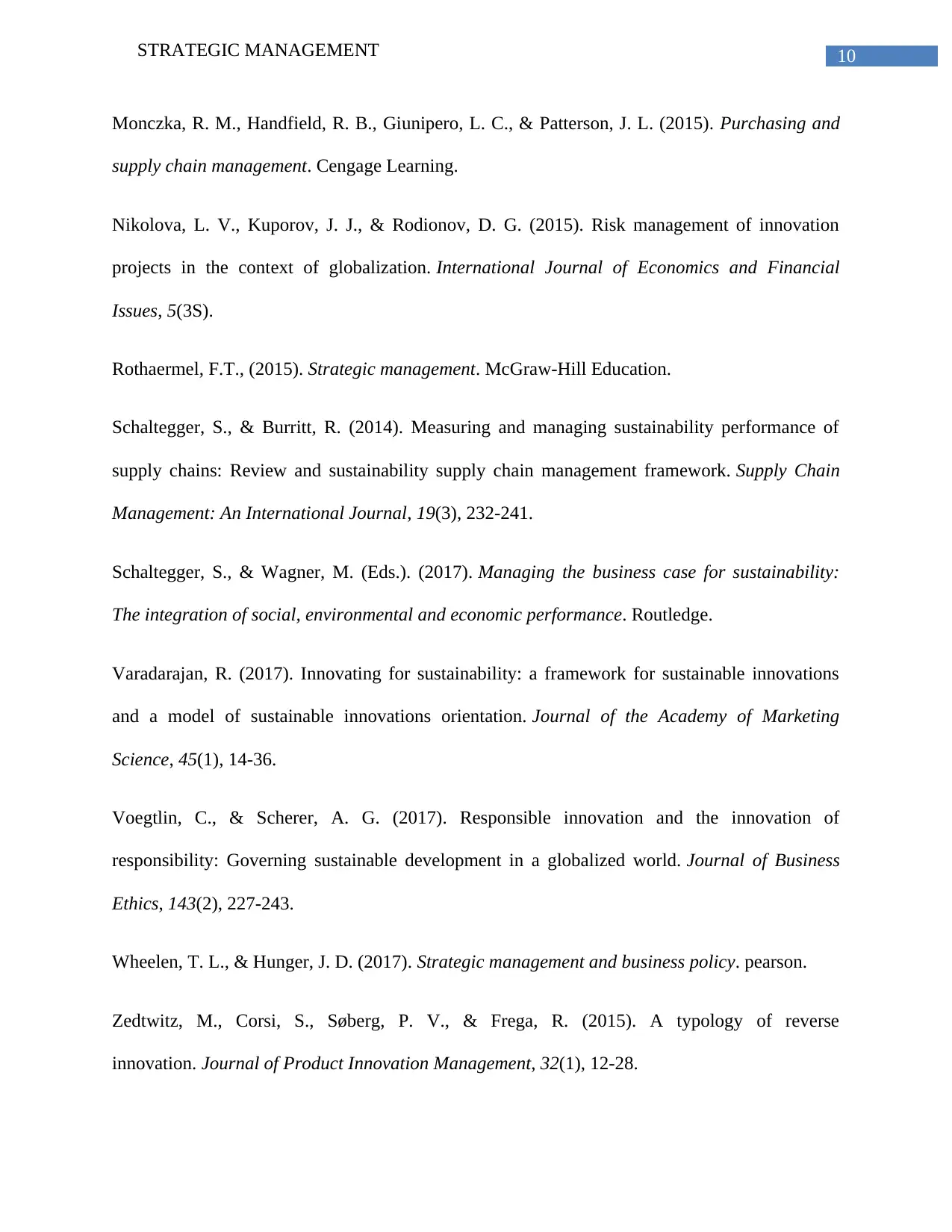
10STRATEGIC MANAGEMENT
Monczka, R. M., Handfield, R. B., Giunipero, L. C., & Patterson, J. L. (2015). Purchasing and
supply chain management. Cengage Learning.
Nikolova, L. V., Kuporov, J. J., & Rodionov, D. G. (2015). Risk management of innovation
projects in the context of globalization. International Journal of Economics and Financial
Issues, 5(3S).
Rothaermel, F.T., (2015). Strategic management. McGraw-Hill Education.
Schaltegger, S., & Burritt, R. (2014). Measuring and managing sustainability performance of
supply chains: Review and sustainability supply chain management framework. Supply Chain
Management: An International Journal, 19(3), 232-241.
Schaltegger, S., & Wagner, M. (Eds.). (2017). Managing the business case for sustainability:
The integration of social, environmental and economic performance. Routledge.
Varadarajan, R. (2017). Innovating for sustainability: a framework for sustainable innovations
and a model of sustainable innovations orientation. Journal of the Academy of Marketing
Science, 45(1), 14-36.
Voegtlin, C., & Scherer, A. G. (2017). Responsible innovation and the innovation of
responsibility: Governing sustainable development in a globalized world. Journal of Business
Ethics, 143(2), 227-243.
Wheelen, T. L., & Hunger, J. D. (2017). Strategic management and business policy. pearson.
Zedtwitz, M., Corsi, S., Søberg, P. V., & Frega, R. (2015). A typology of reverse
innovation. Journal of Product Innovation Management, 32(1), 12-28.
Monczka, R. M., Handfield, R. B., Giunipero, L. C., & Patterson, J. L. (2015). Purchasing and
supply chain management. Cengage Learning.
Nikolova, L. V., Kuporov, J. J., & Rodionov, D. G. (2015). Risk management of innovation
projects in the context of globalization. International Journal of Economics and Financial
Issues, 5(3S).
Rothaermel, F.T., (2015). Strategic management. McGraw-Hill Education.
Schaltegger, S., & Burritt, R. (2014). Measuring and managing sustainability performance of
supply chains: Review and sustainability supply chain management framework. Supply Chain
Management: An International Journal, 19(3), 232-241.
Schaltegger, S., & Wagner, M. (Eds.). (2017). Managing the business case for sustainability:
The integration of social, environmental and economic performance. Routledge.
Varadarajan, R. (2017). Innovating for sustainability: a framework for sustainable innovations
and a model of sustainable innovations orientation. Journal of the Academy of Marketing
Science, 45(1), 14-36.
Voegtlin, C., & Scherer, A. G. (2017). Responsible innovation and the innovation of
responsibility: Governing sustainable development in a globalized world. Journal of Business
Ethics, 143(2), 227-243.
Wheelen, T. L., & Hunger, J. D. (2017). Strategic management and business policy. pearson.
Zedtwitz, M., Corsi, S., Søberg, P. V., & Frega, R. (2015). A typology of reverse
innovation. Journal of Product Innovation Management, 32(1), 12-28.
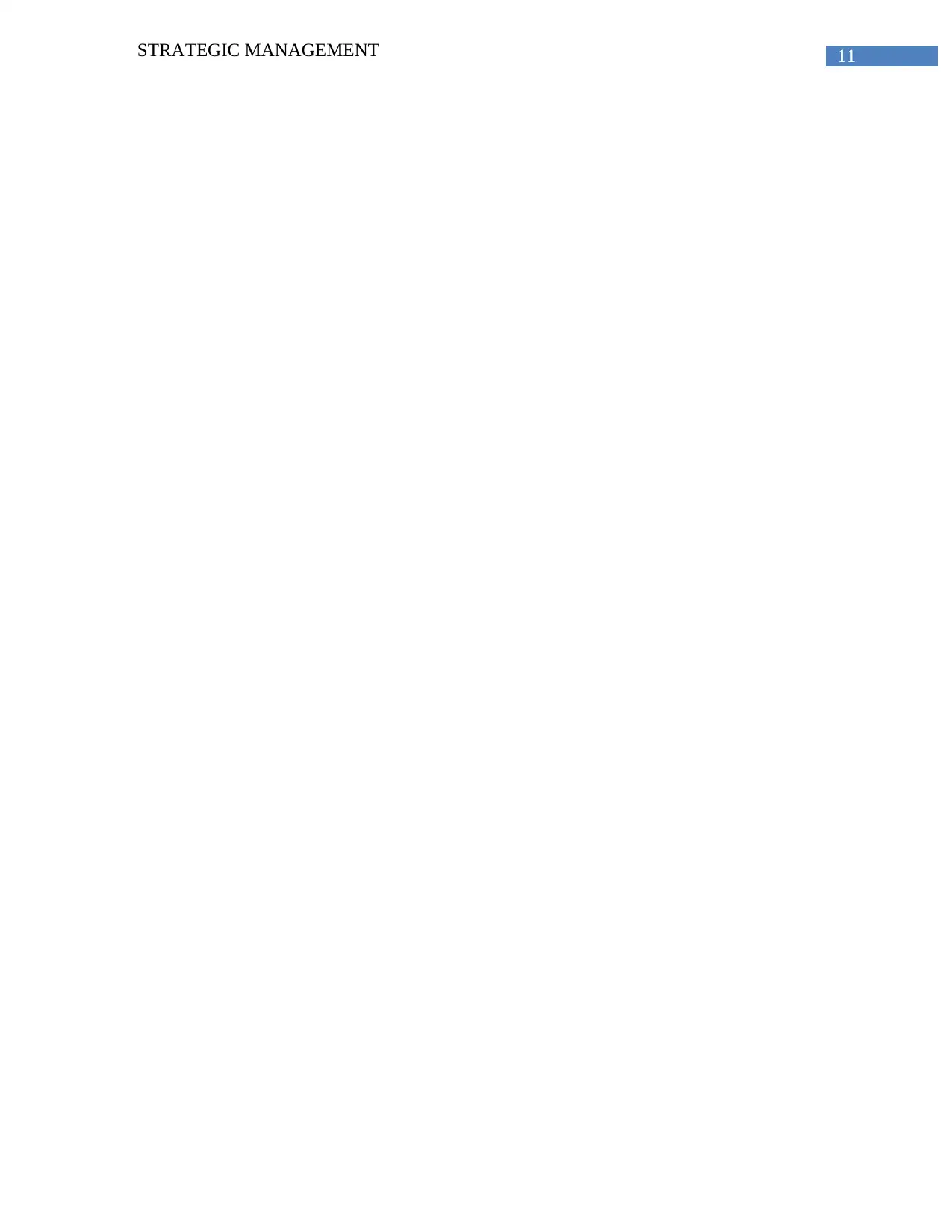
11STRATEGIC MANAGEMENT
⊘ This is a preview!⊘
Do you want full access?
Subscribe today to unlock all pages.

Trusted by 1+ million students worldwide
1 out of 31
Related Documents
Your All-in-One AI-Powered Toolkit for Academic Success.
+13062052269
info@desklib.com
Available 24*7 on WhatsApp / Email
![[object Object]](/_next/static/media/star-bottom.7253800d.svg)
Unlock your academic potential
Copyright © 2020–2025 A2Z Services. All Rights Reserved. Developed and managed by ZUCOL.





